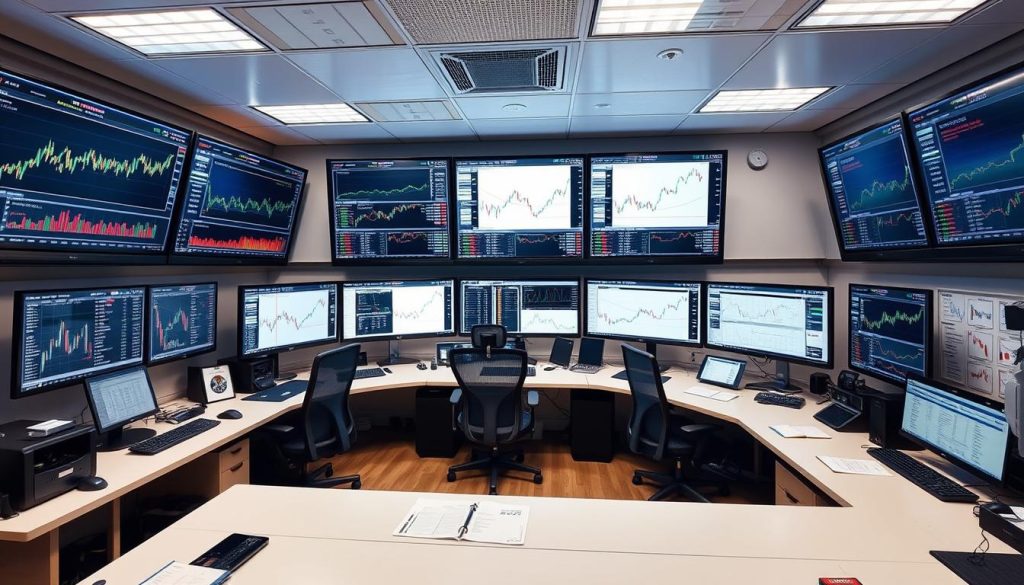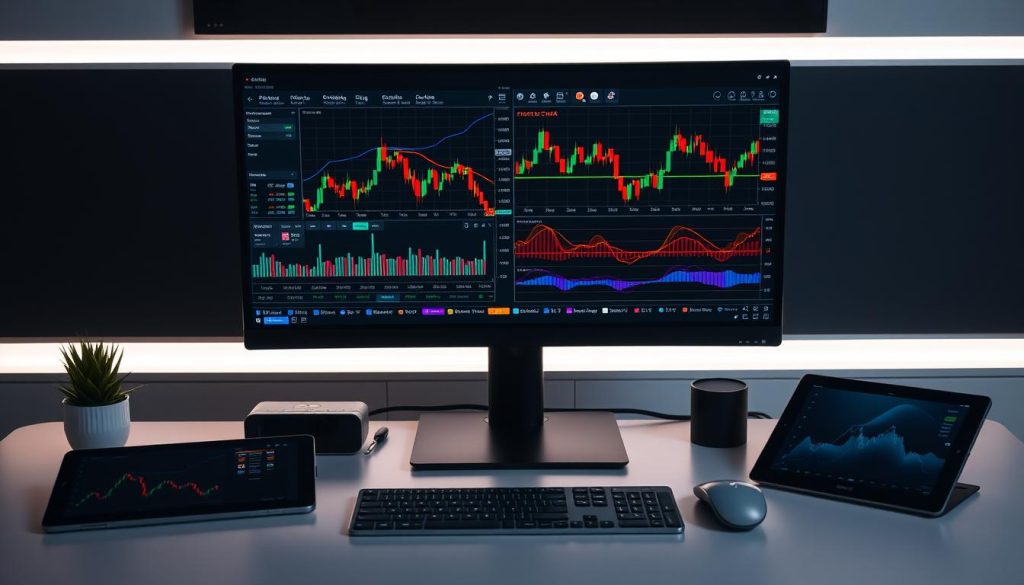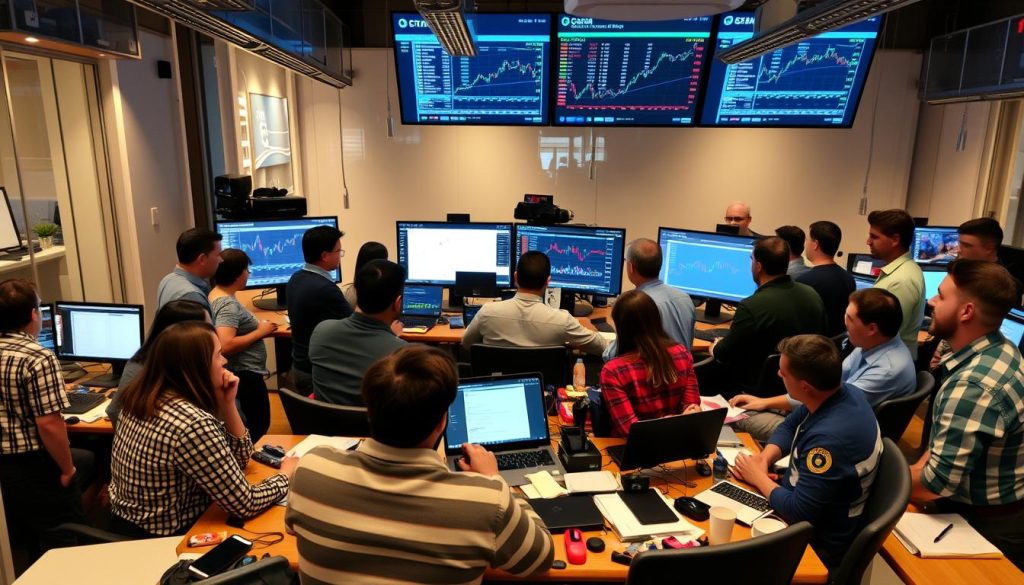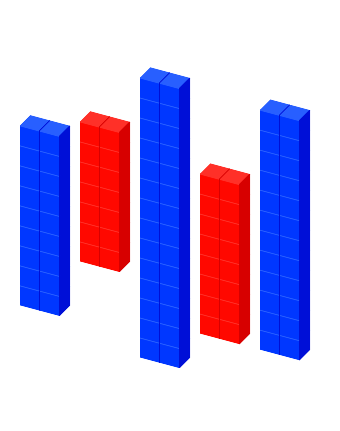Scaling Your Trading After Prop Firm Success
Getting through a prop firm evaluation is a big win for traders. It means moving from a demo to live trading. But, it’s only the start of a bigger challenge – growing your trading business. This guide will show you how to scale your trading after passing a prop firm evaluation. You’ll learn how to reach your full potential in the markets.

Key Takeaways
- Understand the key differences between demo and live trading accounts to manage the psychological and risk management adjustments.
- Develop a sustainable trading framework, including consistent routines, professional trading systems, and comprehensive performance tracking.
- Implement advanced risk management strategies to ensure the stability and growth of your funded trading account.
- Leverage technology and automation to streamline your trading operations and enhance your analytical capabilities.
- Explore techniques for effectively managing multiple prop firm accounts and scaling your trading business.
Understanding the Transition from Evaluation to Funded Trading
Switching from a demo account to a live trading environment is tough for many. Demo accounts are safe for learning, but real-money trading is different. We’ll look at the main differences and how to handle the emotional and practical sides of trading with real money.
Key Differences Between Demo and Live Accounts
Trading with real money feels different than demo trading. Demo accounts let you practice without the stress of losing real money. But, trading with real funds can make you feel scared, hesitant, or too confident. It’s important to stay disciplined and manage your emotions well.
Managing Psychological Adjustments
- Start a psychological preparation routine with mindfulness and stress control.
- Trade in smaller sizes to get used to the real trading world.
- Find a supportive community or mentor for emotional support.
Risk Management in Funded Accounts
When trading with real money, managing risk is key. You need to be careful with how much you trade, when to stop, and how to manage your whole portfolio. What worked in demos might not work with real money.
Review your risk management plans and adjust them for live trading. This might mean trading less, setting tighter stops, and focusing on making more money than you risk. This helps protect your money and trading account.
“The transition from demo to live trading is one of the biggest hurdles for traders to overcome. Developing the right mindset and risk management strategies is crucial for success in funded accounts.”
How to Scale Your Trading After Passing a Prop Firm Evaluation
Congratulations on passing your prop firm evaluation! Now, you start the real journey to grow your trading. Use the capital and chances given by your prop firm to expand your trading. This will help you improve your performance over time.
To grow your trading, think about diversifying your portfolio. Explore new markets, asset classes, and trading strategies to spread out your risk. This way, you can take advantage of more trading chances and make your portfolio stronger.
- Slowly increase how much you trade while keeping an eye on your risks. Watch your performance closely and adjust as needed to grow your trading.
- Get better trading tools and software to help you make decisions faster. Use technology to do routine tasks so you can focus on planning.
- Keep working on your trading skills and strategies. Look at your past trades, find what needs work, and improve to grow your capital and performance.
| Key Factors for Successful Trading Scale | Strategies to Implement |
|---|---|
| Portfolio Diversification | Explore new markets, asset classes, and trading strategies |
| Risk Management Discipline | Gradually increase trading volume while monitoring performance |
| Technology Leverage | Invest in advanced trading software and analytical tools |
| Continuous Improvement | Refine trading strategies and techniques based on performance analysis |
By using these strategies, you can grow your trading and reach your full potential with your prop firm. This will lead to lasting growth in your capital and better performance.

“The key to scaling your trading is to maintain a relentless focus on continuous improvement and risk management. By leveraging the resources and support of your prop firm, you can confidently navigate the journey to greater trading success.”
Building a Sustainable Trading Framework
Creating a solid trading framework is key for lasting success. It means setting up regular trading routines, using top-notch trading systems, and tracking your performance. These steps help build a strong trading base for your future growth.
Creating Consistent Trading Routines
Having a steady trading routine is vital for discipline and better performance. It includes specific times for market analysis, planning, and reviewing trades. A good routine keeps you focused and ensures important tasks are done every time.
Implementing Professional Trading Systems
Moving to a live account means using advanced trading tools. This includes top charting software, automated algorithms, and risk management tools. These systems improve your trading decisions and keep you competitive.
Documentation and Performance Tracking
Keeping detailed records and tracking your performance is crucial. It helps you see your trading strengths and weaknesses. By monitoring your progress, you can tweak your routines and systems for better results.
| Key Components of a Sustainable Trading Framework | Description |
|---|---|
| Consistent Trading Routines | Establishing a structured daily/weekly schedule for market analysis, trade planning, execution, and post-trade review. |
| Professional Trading Systems | Leveraging advanced charting software, automated trading algorithms, and sophisticated risk management tools. |
| Thorough Documentation and Performance Tracking | Maintaining detailed trading journals, analyzing performance metrics, and regularly reviewing trading strategies. |
“Consistency is the key to sustainable success in trading. By building a framework that supports your growth, you can unlock your full potential and achieve long-term prosperity in the markets.”
Risk Management Strategies for Funded Traders
As a funded trader, managing risk is key to your success. Learning about risk control, drawdown management, position sizing, and stop-loss strategies is crucial. It can make or break your trading career.
Proper position sizing helps manage your risk. By setting a specific percentage of your account for each trade, you avoid big losses. Using stop-loss orders also helps limit losses and keeps your capital safe.
Understanding drawdown management is vital in volatile markets. Diversifying your trades and watching your risk-to-reward ratios are key. They help you stay on track and reach your trading goals.
| Risk Management Strategy | Key Benefits |
|---|---|
| Position Sizing | Optimizes risk exposure, prevents account depletion |
| Stop-Loss Strategies | Limits potential losses, preserves trading capital |
| Drawdown Management | Mitigates the impact of market volatility, ensures long-term sustainability |
Using these risk management strategies can help you grow in funded trading. They build a strong foundation for long-term success.

“The key to successful trading is not in making the right decisions, but in managing the inevitable mistakes.”
Leveraging Technology for Trading Scale
In the fast-paced world of trading, technology is key for traders looking to grow. Using trading software, algorithmic trading, data analysis, and automation can boost efficiency and performance.
Essential Trading Software and Tools
Choosing the right trading software and tools is crucial. These include advanced charting platforms, market data feeds, and order execution systems. The right tech stack can make trading smoother and offer valuable insights. Traders should pick tools that fit their strategies and risk management plans.
Automation and Algorithm Development
Algorithmic trading has changed the game, allowing traders to automate their work. By creating custom algorithms, traders can make precise trades and adapt to market changes quickly. Automation saves time, letting traders focus on deeper analysis and decision-making.
Data Analysis and Reporting Systems
For traders aiming to grow, data analysis and reporting are key. Advanced platforms and tools help spot patterns, refine strategies, and track performance. Integrating these systems into their workflow helps traders understand market dynamics better and make informed choices.
| Trading Software | Algorithmic Trading | Data Analysis |
|---|---|---|
| Advanced charting platforms Market data feeds Order execution systems | Custom algorithm development Backtesting and optimization Adaptive trading strategies | Performance tracking Market trend analysis Strategy evaluation |
By using trading software, algorithmic trading, and data analysis, traders can open up new opportunities. These tech solutions streamline workflows, enhance decision-making, and give traders an edge in the markets.

Managing Multiple Prop Firm Accounts
As a successful trader, managing multiple funded accounts is a great opportunity. It lets you diversify, allocate, and distribute risks. This strategy is key to growing your trading portfolio.
Using multiple prop firm accounts helps spread out your trading risks. By putting your capital in different places, you avoid big losses from one bad event. This way, you keep your trading success steady.
| Benefit | Description |
|---|---|
| Account Diversification | Spread your trading capital across multiple prop firm accounts, reducing the impact of individual account losses. |
| Multi-Account Management | Develop efficient strategies to allocate trading capital and monitor performance across various prop firm platforms. |
| Trading Allocation | Thoughtfully distribute your trading volume and strategies to leverage the unique strengths of each prop firm account. |
| Risk Distribution | Mitigate overall trading risk by spreading your exposure across different prop firm accounts and trading environments. |
Good multi-account management needs careful planning and smart capital use. Knowing each prop firm’s rules is crucial. With a solid plan, you can maximize your trading success.
“Diversification is the only free lunch in finance.”

Advanced Position Sizing Techniques
In trading, knowing how to size your positions is key. It’s not just about managing risk. Advanced traders use special techniques to make the most of their money. These strategies help them grow their trading.
Portfolio Balance Strategies
Having a balanced portfolio is crucial for managing risk and making steady profits. Portfolio balance strategies mean spreading your money across different trades and markets. This way, you can lower your risk and aim for steady growth.
Risk-Adjusted Position Calculations
Older methods of sizing positions are simple but not always effective. Risk-adjusted position calculations are more complex. They consider things like volatility and expected returns. This helps you set the right size for each trade based on its risk and reward.

Using these advanced position sizing methods can help you grow your trading in a smart way. By focusing on portfolio balance and risk-adjusted calculations, you can handle the markets better. This sets you up for success in the long run.
Developing a Professional Trading Business Structure
As a successful trader, setting up a solid trading business is key. It helps you run your operations smoothly, follow the law, and manage your money well. This part talks about the main steps to build a strong trading business framework. We’ll cover legal setup, tax planning, and business operations.
Legal Structure and Compliance
Picking the right legal structure for your trading business is vital. You need to think about liability protection, taxes, and rules. Talk to a lawyer to find the best choice for you. It could be a sole trader, partnership, or LLC.
Tax Planning Strategies
Good tax planning can really boost your trading business‘s profits. Work with a skilled accountant to find ways to cut taxes. They can help you use tax-friendly investments and follow all tax laws.
Operational Best Practices
Keeping your business operations smooth is crucial for growth. Use strong record-keeping, automate tasks, and set up clear processes. This helps with client work, trading, and money handling.
| Key Considerations for a Professional Trading Business |
|---|
| Legal Structure and Compliance Tax Planning Strategies Operational Best Practices Risk Management Protocols Branding and Marketing |
By focusing on these important areas, you can make your trading business strong. This ensures you follow the rules, manage your money well, and grow your trading career.
Market Analysis and Advanced Trading Strategies
As a trader, you need to understand market dynamics and use advanced strategies. We’ll look at how market analysis and advanced trading strategies work together. This will help you improve your trading skills.
Technical Analysis Enhancement
Knowing how to use technical indicators is key for traders. By learning more about technical indicators, you can make better trading choices. You’ll be able to spot trends, patterns, and predict market changes.
- Leverage advanced charting techniques to uncover hidden market signals
- Develop expertise in interpreting complex technical indicators and their interplay
- Combine multiple technical tools to create robust, multilayered trading strategies
Fundamental Trading Integration
Technical analysis is a good start, but adding fundamental analysis can make you even better. Understanding the economic and market drivers helps you make smarter choices. You’ll be able to predict market changes more accurately.
| Technical Analysis | Fundamental Analysis |
|---|---|
| Focuses on price movements and market behavior | Examines economic, financial, and industry factors |
| Utilizes charts, indicators, and patterns | Considers macroeconomic data, company financials, and industry trends |
| Aims to identify short-term trading opportunities | Seeks to uncover long-term investment potential |
By mixing fundamental analysis with your trading strategies, you’ll understand the markets better. This leads to more informed and balanced trading decisions.

“The key to successful trading is to combine technical and fundamental analysis to create a well-rounded, data-driven trading approach.”
Building Your Trading Support Network
As a professional trader, having a strong support network is key. Connecting with other traders, finding mentors, and taking part in professional development can change your game. You’ll gain a lot of knowledge, resources, and support to help you grow.
Networking in the trading community lets you learn from others, share ideas, and work together on strategies. You can join online forums, go to industry events, or be part of trading groups on social media. These connections offer valuable learning and support from peers.
Getting mentorship from experienced traders can really boost your career. Mentors can guide you, share their knowledge, and help you make better trading decisions. They can also help you understand the market better.
- Find successful traders who inspire you and ask if they can mentor you.
- Be ready to learn, listen, and use the advice and strategies your mentor gives you.
Also, investing in professional development can improve your trading skills and knowledge. Go to trading workshops, join webinars, or take online courses. These can help you learn more about market analysis, risk management, and trading strategies.
| Professional Development Opportunities | Key Benefits |
|---|---|
| Trading Workshops | Hands-on training, interactive sessions, and practical implementation |
| Online Courses | Self-paced learning, access to expert instructors, and flexible scheduling |
| Webinars | Real-time insights, industry updates, and live Q&A sessions |
By networking, finding mentors, and investing in your growth, you can build a strong support network. This network will help take your trading career to new levels. Use the power of community, sharing knowledge, and continuous learning to achieve success as a funded trader.

Financial Planning and Capital Allocation
As a successful funded trader, it’s key to have a solid financial plan. This means using smart profit distribution strategies and investing in trading infrastructure. These steps help your business grow and stay strong over time.
Profit Distribution Strategies
Deciding how to use your trading profits is important. You need to balance keeping money for your business, personal safety, and growth. Here are some tips for smart profit use:
- Make a plan to keep some profits for capital management and to reduce risks.
- Set aside money for personal financial planning, like saving, investing, and living expenses.
- Use some funds to upgrade your trading technology and tools. This keeps you competitive.
Investment in Trading Infrastructure
Good traders know to invest in their tools and systems. This includes:
- Getting the latest trading software and analytical tools to improve your trading.
- Improving your data management systems for better information handling.
- Looking into algorithmic trading strategies and automation to grow your business.
| Metric | Value |
|---|---|
| Profit Retention Ratio | 30% |
| Personal Financial Planning Allocation | 40% |
| Trading Infrastructure Investment | 30% |
By matching your financial planning and capital allocation plans, you can create a strong trading business. This business will help you succeed in the long run.
Navigating Prop Firm Rules and Restrictions
As a funded trader, it’s key to understand the rules of your prop firm. These rules help keep trading fair and ensure everyone follows the same rules. Knowing and following these rules can help you trade better and avoid problems.
Prop firms have specific trading guidelines like rules on how much to trade and how much risk to take. It’s important to know these rules to stay in good standing and avoid getting your account suspended or closed.
Prop firms also have compliance requirements that traders must meet. This includes reporting trades, following anti-money laundering rules, and giving accurate personal and financial info.
Good account management is crucial for following prop firm rules. This means keeping track of your trades, watching your balance, and staying within the firm’s limits. Talking to your prop firm’s support team can also help with any problems or questions.
“Successful trading within prop firm guidelines requires a disciplined approach and a deep understanding of the firm’s policies. By embracing compliance, you can unlock the full potential of your funded account.”
By following prop firm regulations, you can improve your trading and keep a good relationship with your prop firm. This can help your trading business grow and get bigger.
| Key Prop Firm Regulations | Compliance Requirement | Account Management Strategies |
|---|---|---|
| Position sizing limits Leverage restrictions Risk management guidelines | Reporting trading activities Anti-money laundering policies Accurate personal and financial information | Meticulous trade tracking Monitoring account balance Proactive communication with prop firm support |
Conclusion
After overcoming the hurdles of prop firm evaluations and setting up a funded trading account, the next steps are crucial. Growing your trading business is a continuous journey. It needs ongoing learning, a deep focus on market analysis, and strict risk management.
Keeping a positive trading mindset is key. It helps you seize growth chances and keep improving. By regularly checking your trading plan, automating tasks, and building a strong support network, you’ll become more resilient in the markets.
Your path to trading success shows your hard work, flexibility, and dedication. By staying alert to market shifts, sharpening your analysis skills, and maintaining discipline, you’re set to grow your trading business. This will lead to lasting success in the financial world.
FAQ
What are the key differences between demo and live trading accounts?
Trading with real money is different from demo accounts. It affects your emotions and how you manage risk. Live trading also comes with challenges like slippage and execution issues.
How can traders manage the psychological adjustments when transitioning to funded accounts?
Traders can handle the emotional shift by controlling their emotions. They should stick to a routine and slowly increase their trading size. This helps them get used to the pressure of real trading.
What are the essential risk management strategies for funded traders?
Funded traders need to size their positions correctly and manage drawdowns well. They should use stop-loss orders and trade in various markets. This spreads out risk and helps protect their capital.
How can traders leverage technology to scale their trading operations efficiently?
Traders can use software, automation tools, and data analysis to improve their trading. These tools help them create algorithms and stay competitive in the markets.
What are the considerations for managing multiple prop firm accounts simultaneously?
Managing many accounts requires diversifying risk and allocating capital wisely. Traders must perform well on different platforms. They also need to follow each firm’s rules.
How can traders develop a professional trading business structure?
Creating a professional trading business involves setting up a legal entity and planning taxes. Traders need to keep books and follow best practices. This ensures they are compliant and financially sound.
What advanced market analysis techniques and trading strategies can traders explore?
Traders can improve by using advanced technical indicators and fundamental analysis. They can also develop complex trading strategies. This boosts their market performance.
How can traders build a strong support network within the trading community?
Traders can connect with others and find mentors. Joining webinars, workshops, and online communities helps. This builds a supportive network.
What are the key considerations for effective financial planning and capital allocation as a funded trader?
Funded traders need to plan their finances well. This includes how to distribute profits and invest in trading tools. They must manage their capital to grow their trading business.
How can traders navigate the rules and restrictions set by prop firms?
Understanding prop firm rules is crucial. Traders need to know the guidelines and how to manage their accounts. This keeps them in good standing and helps them trade well within the rules.
